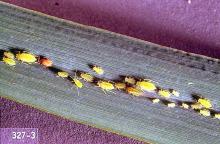Includes
Apple aphid (Aphis pomi)
Apple grain aphid (Rhopalosiphum fitchii)
Spirea aphid (Aphis spiraecola)
Pest description and crop damage All these aphids are light green in color. Spirea aphid is very difficult to separate from apple aphid without high magnification, whereas apple grain aphid can be distinguished by a yellowish green stripe down the middle of the back. Apple grain aphids infest pear only in the early part of the season, while apple aphid is present all summer. Aphids suck plant sap and live in colonies on new shoots. Populations are damaging only sporadically. Damage appears as rolled leaves, stunted terminal growth, and spotting from excreted honeydew.
Biology and life history Aphids overwinter as eggs in crevices and twigs. The eggs hatch near budbreak, and the nymphs feed on the underside of the leaves. After two to three generations, winged forms are produced that migrate to summer hosts, which include weeds, ornamental plants, and vegetables. After several more generations, the winged forms migrate back to fruit trees in the fall to mate and lay the overwintering eggs.
Pest monitoring Begin observing shoots before budbreak, as management is best undertaken early while the aphid populations are small.
Management-biological control
Aphids have many natural enemies which include parasitic wasps, lady beetles, syrphid fly larvae, and green lacewings. Avoid broad-spectrum insecticide applications which disrupt these biological controls.
Management-cultural control
Aphid populations tend to be higher in plants that are fertilized liberally with nitrogen. Avoid excessive watering which, together with nitrogen applications, produces flushes of succulent growth.
Home orchardists: Wash aphids from plants with a strong stream of water or by hand-wiping.
Management-chemical control: HOME USE
.Dormant-season spray
- superior-type oil-Do not apply after delayed-dormant. Apply with enough water to cover the entire tree thoroughly. Some formulations are OMRI-listed for organic use.
Growing-season spray
- acetamiprid-Toxic to bees.
- azadirachtin (neem extract)-Products containing neem extract may be phytotoxic to some pear cultivars. Some formulations are OMRI-listed for organic use.
- Beauveria bassiana-Some formulations are OMRI-listed for organic use.
- bifenthrin-Highly toxic to bees.
- gamma-cyhalothrin-Highly toxic to bees.
- horticultural mineral oil-Some formulations are OMRI-listed for organic use.
- imidacloprid-Soil drenches may have residual activity in woody plants lasting for 1twelve or more months. If short-term management is the goal, consider other approaches. Highly toxic to bees.
- insecticidal soap-Some formulations OMRI-listed for organic use.
- kaolin-Applied as a spray to leaves, stems, and fruit, it acts as a repellant to some insect pests. Some formulations are OMRI-listed for organic use.
- lambda-cyhalothrin-Highly toxic to bees.
- malathion-Highly toxic to bees.
- permethrin-Highly toxic to bees.
- plant-derived essential oils-Some have shown efficacy against aphids. Some formulations are OMRI-listed for organic use.
- pyrethrins (often as a mix with other ingredients)-Highly toxic to bees. Some formulations are OMRI-listed for organic use.
- zeta-cypermethrin-Highly toxic to bees.
Management-chemical control: COMMERCIAL USE
- acetamiprid (Assail 70WP) at 1.1 to 1.7 oz/A. REI 12 hr. PHI 7 days. Do not exceed 4 treatments per calendar year. Do not apply more than once every 12 days. Do not exceed 0.60 lb ai (13.5 oz product) /A per calendar year. Repeated use may induce spider mite buildup.
- clothianidin (Belay) at 4 to 6 fl oz/A. REI 12 hr. PHI 7 days. Only apply post-bloom. Do not exceed 12 fl oz/A per year. Repeated use may induce spider mite buildup.
- diazinon (Diazinon 50W) at 1 lb/100 gal water (100 gal/A minimum). REI 4 days. PHI 21 days. Diazinon is no longer effective in some parts of Washington. Apply as a cover spray when infestation occurs. Applicators must use an enclosed cab, see label for details. One dormant and one in-season foliar application allowed.
- flonicamid (Beleaf 50SG) at 2 to 2.8 oz/A. REI 12 hr. PHI 21 days. Do not exceed three applications per season.
- imidacloprid (Prey 1.6) at 8 fl oz/A. REI 12 hr. PHI 7 days. Apply post-bloom. Repeated use may induce spider mite buildup.
- sulfoxaflor (Transform 50WG) at 0.75 to 1.5 oz/A. REI 24 hr. PHI 7 days. Do not apply between 3 days prior to bloom and until after petal fall.
- thiamethoxam (Actara) at 4.5 to 5.5 oz/A. REI 12 hr. PHI 35 days. Do not apply after pre-bloom (green cluster stage) or before post bloom (petal fall). Repeated use may induce spider mite buildup. Do not exceed a total of 11.0 oz/A (0.172 lb ai/A) of Actara or 0.172 lb ai of thiamethoxam containing products per acre per growing season.



